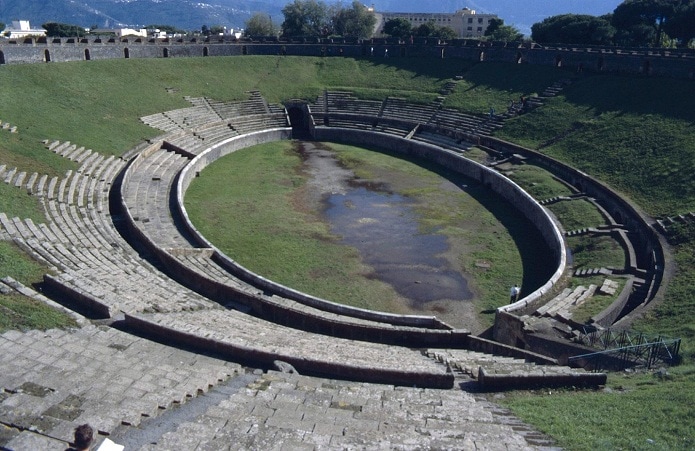|
Today we are going to talk about the amphitheater of ancient Pompeii, one of the most important attractions of the ruins and a suggestive place chosen by artists like Elton John or David Gilmour as location for their spectacular concerts made last summer.
The amphitheater of Pompeii is the earliest known permanent stone amphitheater in Italy (and the rest of the Roman world). It was constructed after 70 BC, and belongs to the period of the Roman conquest and colonization of the town. It includes several features that were to become standard elements of amphitheater design across the Roman Empire. The form derives from the duplication of the structure of the theatre (amphitheater means "double theatre" or "circular theatre"): it is an elliptical structure situated in a depression in the ground and backing onto embankments. It consists of a large cavea around which are the steps, divided into sections, which cover the entire perimeter of the construction. Unlike the other Roman amphitheater, the one in Pompeii does not have an underground section. It was equipped with a velarium, that is a cover which was stretched over the complex in case of rain: the rings to which the canopy was fixed can still be seen. It hosted all the circus shows and the gladiatorial games so dear to the Pompeians, who devoted most of their spare time to these performances. Sports and games in the form of gladiatorial combat was almost a prerequisite to any self-respecting city including a provisional city such as Pompeii. The amphitheater survived the deadly eruption of Mount Vesuvius in 79 AD, but most of the structure remained buried under volcanic debris. It was initially revealed in 1823 when the overlying material was cleared by Michele Arditi and Antonio Bonnucci. However, the whole site was systematically excavated in the twentieth century by the famous Italian archeologist Amedeo Maiuri. We know of earlier amphitheaters from written sources, but these were built at least partially of wood and so have not survived. An inscription tells us that two local officials, Quinctius Valgus and Marcius Porcius built the amphitheater at private expense. With this inscription the two men made sure to underline their generosity for posterity, and for the attention of the voting public. These men would have expected this act to enhance their personal power and prestige, and we know from graffiti found throughout the town that gladiatorial games were extremely popular and a good occasion to catch people’s consent. The amphitheater could seat around 20,000 people, is 445 by 341 feet (136 by 104 meters) and served not only Pompeii but also the inhabitants of surrounding towns. In AD 59, we know from written sources that there was a riot in the amphitheater, in which spectators from Pompeii and the nearby town of Nuceria fought each other, with the result that the Emperor Nero banned games at Pompeii for a period of ten years. Do you want to discover more about the amphitheater of Pompeii? Take a tour of Pompeii with us and time travel to the past! Start by viewing our tours here. Or call our Pompeii office at +39 081 1877 7006.
1 Comment
Leave a Reply. |
AuthorStaff at Flashback Journey to Pompeii. Our goal is to bring you up-to-date information on events, continuing archeological excavations and more on Pompeii. Archives
July 2018
Categories |


 RSS Feed
RSS Feed
